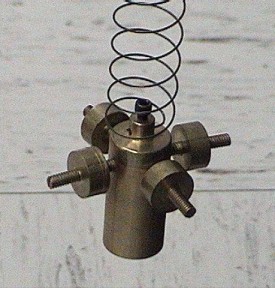Energy is exchanged between the up-and-down and the torsional motion.
Teachable Topics:
- oscillations
- vibrational modes
- momentum
Theory:
A wilberforce pendulum is a bob with outriggers on the side to give it a large moment of inertia. The pendulum has two modes of oscillation: one is the up-and-down motion of a mass on a spring, while the other is the spinning motion of a torsional pendulum.
If the bob is released from rest, it will begin to oscillate up and down. As time goes by, though, it begins to rotate too. Because the total energy of the bob is constant, the bob puts more energy into rotation at the expense of the energy of the up-and-down oscillation. That means that the amplitude of the up-and-down motion decreases as the rotation speeds up, then as the rotation slows down, the up-and-down gains more amplitude, and so on...
Apparatus
- Wilberforce pendulum
- laboratory stand

Procedure:
- Pull the Wilberforce pendulum down a bit, then release. Watch as the pendulum alternates between a twisting and a bobbing motion.
- The positions of side weights may need to be adjusted to achieve the best coupling. Do not over-extend the spring.



